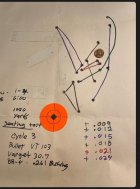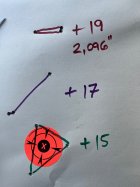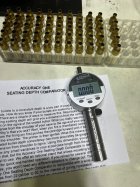At 1000 yards the answer is ‘yes’With so many variables introduced each and every time you pull the trigger , can you tell the difference between bullets seated .002 longer than the last round ?
Install the app
How to install the app on iOS
Follow along with the video below to see how to install our site as a web app on your home screen.
Note: This feature may not be available in some browsers.
You are using an out of date browser. It may not display this or other websites correctly.
You should upgrade or use an alternative browser.
You should upgrade or use an alternative browser.
Inconsistent BTO Measurements
- Thread starter Linko
- Start date
Rwfish
Silver $$ Contributor
You need to know what your tools can give you for accuracy. Remove the cartridge and run your anvil up against the comparator and zero the caliper. Now repeat this action ~10 times using your “normal” finger pressure and log your difference from zero for each check. When complete, these numbers will be the best accuracy you can expect from the tools and method you are using. If your baseline is .0015” at best you can’t expect to achieve better results when measuring your cartridge. Another thing to look at is your neck/bullet concentricity. If this is poor you will find it difficult to get good alignment in the comparator gauge as you rotate to check in the caliper as you are doing.
MikeRu
Gold $$ Contributor
more than a couple thoughts FWIW:
get rid of the round base or anvil, mine is also sensitive to how tight the screw is set so it creates errors just as described above.
2 thou seating depth is about the size the optimal window quite often; you should be able to estimate base to ogive or BTO to the nearest 1/2 thou or 0.0005 with pretty good reproducibility; easy to sort and then retest one group to see how reproducible it is. Make sure the little backside screws are correctly adjusted on your mitutoyo, that seems to matter -- touching but not overtight.
if problems persist then one option is to mount your calipers on the Hoover Accuracy One meplat trimmer body and stand, it has an ogive bulit in and creates a very nice hard stop that seems very reproducible to me for getting BTO; no more using your thumb on the roller you just slide back and forth.
CTK precision (Curt Knit) has a nice substitute for the Hornaday BTO adaptor, it measures a little further out on the bullet nose compared to the Hornady ogive adaptor; Curt's idea is that you get a more reproducible read out on the nose where there's more slope. So it's a good surrogate for BTO and still reports your seating depth just fine (although your absolute number will be different).
I use the Accuracy One Comparator ref'd above to double check datum to ogive AFTER seating bullets to the same base to ogive/BTO. This checks for cases with a different shoulder bump that you might use for a folwer etc.
get rid of the round base or anvil, mine is also sensitive to how tight the screw is set so it creates errors just as described above.
2 thou seating depth is about the size the optimal window quite often; you should be able to estimate base to ogive or BTO to the nearest 1/2 thou or 0.0005 with pretty good reproducibility; easy to sort and then retest one group to see how reproducible it is. Make sure the little backside screws are correctly adjusted on your mitutoyo, that seems to matter -- touching but not overtight.
if problems persist then one option is to mount your calipers on the Hoover Accuracy One meplat trimmer body and stand, it has an ogive bulit in and creates a very nice hard stop that seems very reproducible to me for getting BTO; no more using your thumb on the roller you just slide back and forth.
CTK precision (Curt Knit) has a nice substitute for the Hornaday BTO adaptor, it measures a little further out on the bullet nose compared to the Hornady ogive adaptor; Curt's idea is that you get a more reproducible read out on the nose where there's more slope. So it's a good surrogate for BTO and still reports your seating depth just fine (although your absolute number will be different).
I use the Accuracy One Comparator ref'd above to double check datum to ogive AFTER seating bullets to the same base to ogive/BTO. This checks for cases with a different shoulder bump that you might use for a folwer etc.
ELR LVR
Silver $$ Contributor
I like the repeating pattern shown here, Nice Job!!!Absolutely YES !
A recent seating depth test, paper doesn’t lie
View attachment 1701501
View attachment 1701502
Exit timing is critical, consistent exit timing even moreso
(For long range accuracy anyway)
DShortt
Gold $$ Contributor
I've made a few seating stems so that.the contact point is closer to the ogive.are you using the correct seating stem? you may be seating off the point of the bullet
If you remove your seating stem, take a bullet and insert it into the stem and it wobbles, that's never going to be consistent.
To be fair, I know why they are made that way. In order to accommodate all bullet nose profiles.
DLT
Silver $$ Contributor
That’s how I do it anywaysMaybe its me , but id flip the comparator around.
Use the thumb wheel to apply light pressure while spinning the round.
Last edited:
With respect to the advantage of measuring seating depth from the shoulder (AI) versus the base (Hornady), I'm missing something. Lets say two fired cases are body-sized in order to bump the shoulders, and they both indicate the same distance from base to shoulder after sizing. Bullets are seated; the Hornady gage indicates both cartridges have identical seating depths, the AI gage indicates they don't. Since both cases are identical from base to shoulder, I don't see how the two gages can disagree. Help me out please  .
.
If you still find you're not getting the consistent seating depth reading with your new Accuracy One tool, one of the things it could be is the variations in the bullet's BTO's. For me, this was the final thing I found and will sort my bullets by their BTO as measured from the base of the bullets to the part of the ogive where the seating stem touches. Since I've been doing that, I get really really consistent seating depths when seating my bullets.Ok, doing my seating depth process a total change.
Was: Hornady tool and caliper (BTO) finding both lands and cartridge seating.
New: Wheeler method to find the lands, and the Accuracy One shoulder to ogive tool
I sort using my caliper and a comparator insert that's matches the contact point of the pin in my seating die. This BTO sorting really works for consistent seating. If you want, you can also use your new Accuracy One tool to sort by placing the bullets on a flat surface and pressing down the tool flat to the surface as the contact point on the ogive is really close to the same as a seating pin. But, I found using caliper and comparator much faster than using this tool.
64Rambler
Gold $$ Contributor
I was getting a good spread in BTO measurements as well with the Hornady tools. Getting rid of the base anvil and just using the caliper jaw for the base tightened up the spread a bit, but switching to the Derraco comparators tightened it even further. Both being aluminum, I'm guessing the Derraco may be harder? I try not to jam the bullet into the comparator as that really broadens the BTO measurement, but I do spin the cartridge a bit until I get the shortest number that's repeatable.
Supposedly, the idea is to find a wide seating window, up to .006 as some say, then try to seat in the middle of it. The comparator version doesn't really matter, all it does is establish a length from whatever given reference point the tool measures from on the case, to the given reference point on the bullet ogive, at whatever point that diameter occurs on that ogive. Comparator tools can be +/-.001, measuring system can be +/-.001, bullets could vary in diameter at the same spot, +/- .0005 will give you a different measurement at that given point, as it is the tool governing where that point is.. Even to start with, OAL to jam measuring with the removing the bolt method and using the tape like Cortina/Speedy shows, induces an unknown variable of within his .002 piece of tape. If a person can wind up at +/-.001, maybe even .002, across the board, in whatever quantity they load, with whatever tools they use to measure it, be it from shoulder or base, they're doing well. As I understand it, all you need to do, is stay in the window.
Fast14riot
Gold $$ Contributor
I use the hornady tool, but not the base anvil. With good bullets I get very consistent measurements from dial calipers. I also seat with inline dies in an arbor press.
Regarding different tools measuring different amounts, indicating off a curved surface it difficult and if measuring in different places minute angular differences between the two locations can exaggerate the readings.
With BTO measurements don't forget about the condition of the case base and primer seating depth. If you have ejector marks, swipes, bent rims all of those can and will affect BTO.
Regarding different tools measuring different amounts, indicating off a curved surface it difficult and if measuring in different places minute angular differences between the two locations can exaggerate the readings.
With BTO measurements don't forget about the condition of the case base and primer seating depth. If you have ejector marks, swipes, bent rims all of those can and will affect BTO.
Similar threads
- Replies
- 27
- Views
- 5,449
Upgrades & Donations
This Forum's expenses are primarily paid by member contributions. You can upgrade your Forum membership in seconds. Gold and Silver members get unlimited FREE classifieds for one year. Gold members can upload custom avatars.

Click Upgrade Membership Button ABOVE to get Gold or Silver Status.
You can also donate any amount, large or small, with the button below. Include your Forum Name in the PayPal Notes field.
To DONATE by CHECK, or make a recurring donation, CLICK HERE to learn how.

Click Upgrade Membership Button ABOVE to get Gold or Silver Status.
You can also donate any amount, large or small, with the button below. Include your Forum Name in the PayPal Notes field.
To DONATE by CHECK, or make a recurring donation, CLICK HERE to learn how.













